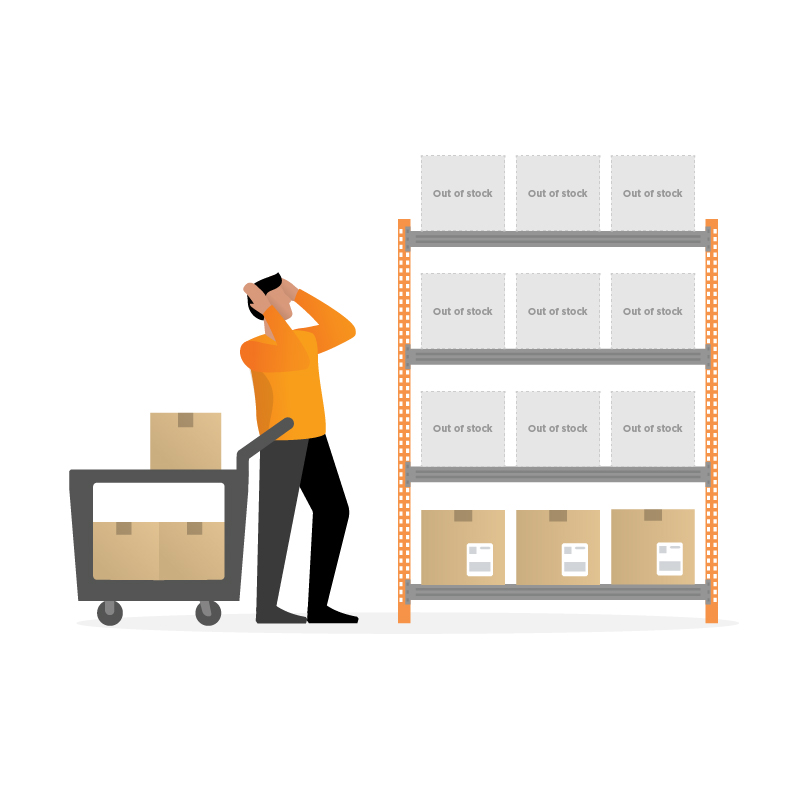As a manufacturer or brand selling products online, the worst thing you can do to hurt customer relations is overselling — or promising inventory that you can’t deliver. An order management system (OMS) helps to prevent that.
How does overselling happen?
Online shoppers today rightly expect they can buy what’s advertised on ecommerce websites. You’re in danger of overselling when you overpromise the same quantity to multiple customers on different channels.
Overselling occurs when you run out of stock on an item but still allow consumers to make online purchases on it. This happens because of inaccurate stock counts, insufficient safety stock, a buying surge, or slow inventory syncs to other systems.
Did you know Deposco offers a cohesive SCP + Fulfillment solution? Replace inefficient manual processes with instant recommendations and automated workflows. Lower your carrying costs, optimize labor, increase sales, and become more proactive in approaching inventory as one entity across touchpoints.

Impact of overselling
Not surprisingly, overselling results in unhappy customers. Even if you place a backorder with a supplier to fill an out-of-stock item, expect a delay in fulfillment and shipping.
Once you inform the customer of that delay, it leads to either an order cancellation or a customer frustrated about waiting longer than expected for item delivery. Either way, you ruin a customer relationship, risk losing future business, and damage your reputation.
Overselling wastes money spent on customer acquisition
You spend massive marketing dollars and time building brand trust for your online business to acquire new customers and sales. Although customer acquisition cost varies by industry and business type, the average expense is $58.64 per customer for a small ecommerce business, according to a Shopify/Angus Reid survey.
If you can prevent overselling, you avoid undermining all that work and effort.
According to TCN Inc.’s third annual “Consumer Insights about Customer Service” survey conducted by OnePoll, 73% of consumers are inclined to switch brands following a negative brand experience. This represents a notable increase compared to 2022 when 66% expressed the same intention, and it nearly doubles the figure of 42% from 2021.
Loyal customers are more likely to give you another chance if they have a negative experience, but first-time customers are more likely to jump to another brand selling similar items.
Let’s put this example into dollars. If 73% of first-time customers leave after a negative experience and you have to cancel 10% of customer orders due to not having the inventory you promised when you took the sale, that leads to wasted customer acquisition spend of $164,828/yr. This assumes 500 orders/day and a retail industry average customer retention of 63%.
That’s a huge financial blow to your business as you need repeat customers to achieve profitability. Making amends won’t be easy, if possible at all, once you’ve disappointed an online shopper.
3 ways to prevent overselling
Anytime you’re selling items on multiple channels, there’s an inherent risk of several customers trying to buy the same item simultaneously. Companies take 3 different approaches to prevent overselling, with OMS offering superior protection.
2 traditional (but not recommended) approaches
- Segregate Items For Each Channel: Channel segregation eliminates the risk of promising the same inventory unit across multiple channels. While this sounds like a great idea, making only a portion of your inventory available on any given sales channel will hamper overall sales. That’s especially true if you don’t carry a deep inventory amount for a particular item. Not exposing all of your inventory on your website prevents you from maximizing your sales and revenue.
- Hide Safety Stock From Public View: Another option is to hold back a portion of your inventory from being displayed on your website. The set-aside stock could account for inventory inaccuracies and customers placing orders on different channels for the same items in close sequence.
To do that, however, you must ensure that your inventory management systems allow for withholding that safety buffer from the available-to-promise (ATP) number published to your sales channels. This number can either be set at the network or fulfillment location levels.
Without an OMS you must set the number at the location level, meaning you must hold back some stock at each warehouse or store. If you have a large fulfillment network, you’ll likely hold back a large amount of inventory across numerous locations. Doing it this way is arbitrary and jeopardizes sales.
Business changes, demand patterns change, and establishing islands of inventory can quickly create stockouts in places you could be selling while you’re defending inventory in locations that aren’t selling.
Keeping a stockpile increases your overall inventory holding costs but also ties up precious working capital.
The 3rd and best option…
OMS with real-time visibility
To prevent overselling and overpromising, you need real-time visibility of your inventory holdings across your entire network of warehouses and stores.
Through OMS software, you can get an accurate, up-to-the-minute picture of what individual items are in stock and where they are located in your network.
The system keeps that picture updated in real time so you can keep a steady pace with buying activity across all channels, whether in stores, on your website, or any affiliate websites.
Finally, you can easily connect the system to your inventory management system that tracks store and warehouse holdings. That way you provide the most accurate information on product availability online or anyplace else.
Keep your promises in multiple channels
Ecommerce is highly competitive today, and online shoppers expect prompt fulfillment and delivery of any item advertised for purchase. For your online business to succeed in a tough marketplace, you must support and manage rapid buying engagement with multiple customers and channels simultaneously.
Overpromising or overselling dampers engagement and destroys customer loyalty.
With an OMS providing real-time inventory visibility across your network, you avoid making promises you can’t keep — even when dealing with customers across a multitude of channels.
More than ever, you need an intelligent order management solution that offers an all-encompassing view of all stock holdings with no lag across your entire selling network. OMS can also withhold designated buffer-stock inventory from what’s published as available for sale.
With an intelligent OMS linked to your inventory management system, you’re now positioned to keep your promises of product availability, avoid overselling, and retain customer loyalty for repeat sales.

